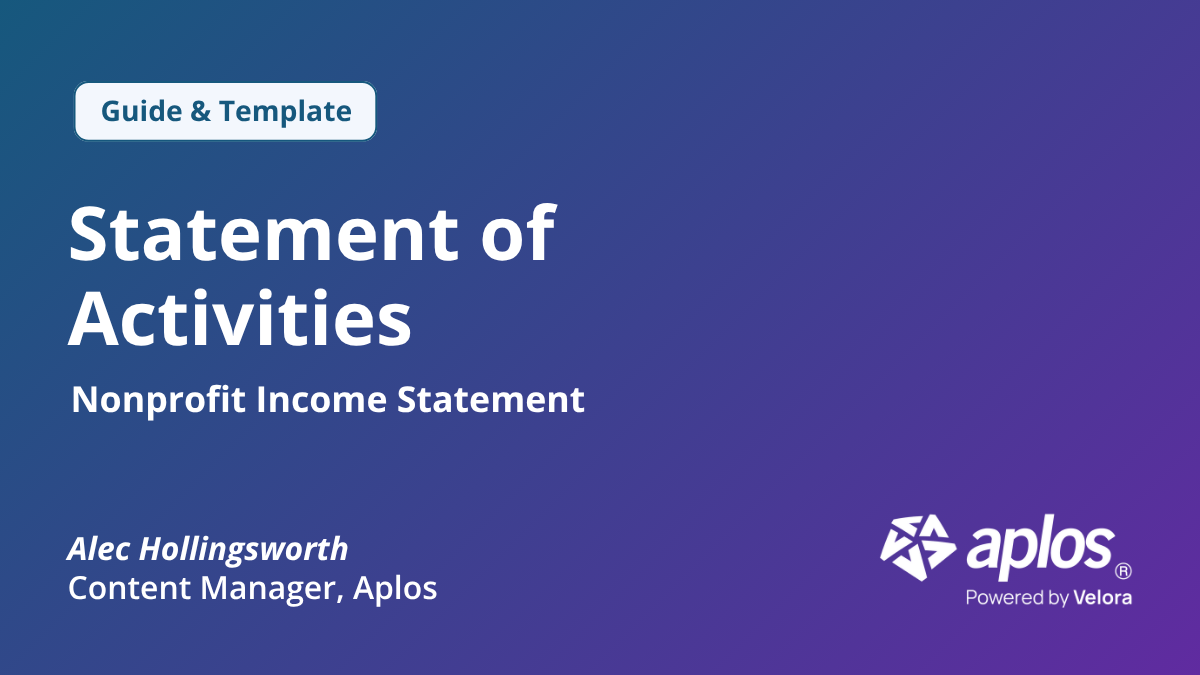
Categorizing Nonprofit Expenses

Back in 2016, the FASB (Financial Accounting Standards Board) approved several changes regarding nonprofit financial statements. One of the more significant rules, also known as ASU 2016-14, states that all nonprofit organizations must report expenses on financial statements based on their purpose. This new form of categorization, officially referred to as functional expense allocation, can be confusing to established nonprofits and new or startup nonprofits that are not familiar with reporting expenses in this manner.
This article aims to simplify functional expense allocation methodology and will walk you through the process of categorizing expenses for your operating budget.
Learn how Aplos can make your nonprofit run more efficiently. Try it free for 15 days.
The Most Common Categorization of Nonprofit Expenses
While there are multiple classifications for expenses, the three that are primarily used for this type of reporting are Program, Administrative, and Fundraising. Here is a brief introduction to these particular nonprofit expense categories:
Program Expenses
This category is for any expenses where goods and/or services are being provided. In a perfect world, most of your expenses would be allocated to this grouping, since donors tend to be drawn to nonprofits that spend the majority of their money on programs.
Examples of Program Expenses
Some instances of program expenses would be costs related to teaching a class, delivering clothing to underprivileged families, or running a camp.
Administrative Expenses
This class of expenses refers to any spending that is related to the operation and management of your nonprofit. While these costs are essential, they are typically not directly related to the organization’s mission.
Examples of Administrative Expenses
Examples of administrative or general expenses would include costs connected to meetings, insurance, or bookkeeping.
Fundraising Expenses
Expenses allocated to this category would be any costs that are related to generating financial support or a contribution for your organization. Similar to administrative costs, donors typically prefer to work with nonprofits that have minimal fundraising expenses.
Examples of Fundraising Expenses
Expenditures that can be classified as fundraising costs may include postage and printing costs for donor acknowledgment letters, expenses related to fundraising campaigns, and costs related to maintaining donor and supporter lists.

How to Classify Expenses for Your Operating Budget
While the previous section is meant to clear up some of the confusion with allocating expenses, not all expenses are black and white when it comes to functional classifications.
Here are some tips when it comes to expense allocation:
- The IRS does not have any firm rules when it comes to allocating expenses. The primary objective is to clearly show how your organization’s money is being spent.
- There is no clear-cut consensus for determining how operating expenses should be dispersed. Many nonprofits come up with a ratio that works for their specific needs and goals.
- One common benchmark used to measure the health of a nonprofit is to check the overhead costs (combined expenses for administrative and fundraising). If it is 25% or less, this is typically an indicator of a healthy organization.
- Create an allocation plan for your organization and then keep a handwritten version on file. Make sure the plan is easy for board members, auditors, and any other viewers to read and understand.
- Build a custom chart of accounts that conveys your nonprofit’s allocation policy in a clear and concise way. A well-planned chart of accounts is the cornerstone of your organization’s finances, so it is imperative to take the time to create one that is flexible and detailed, while remaining simple enough for board members and potential donors to understand.
Assistance With Allocating Expenses and Creating a Custom Chart of Accounts
While this guide should help simplify the allocation process, understanding this concept is only half the battle. The next step is to implement these rules and strategies, which can be intimidating for both new and experienced nonprofits.
Fortunately, there is a solution on the market that takes the guesswork out of nonprofit accounting tasks like these. Aplos was created with the unique needs of nonprofit organizations in mind, and thousands of nonprofits use it to streamline their accounting.
Frequently Asked Questions
What is functional expense allocation?
Functional expense allocation is reporting your expenses on financial statements based on their purpose, per ASU 2016-14.
What are the primary nonprofit expense categories?
The three primary categories are Program, Administrative, and Fundraising expenses.
What are examples of program expenses?
Program examples include costs for teaching classes, delivering clothing to families, and running a camp.
How should you document your allocation policy?
You should create an allocation plan, keep a handwritten copy on file, and build a clear, custom chart of accounts.
What overhead benchmark indicates a healthy nonprofit?
Aim for combined administrative and fundraising overhead of 25% or less; this commonly indicates a healthy organization.

Our comprehensive closeout services start at $399 per month that needs to be reconciled. Sign up before Jan 1st and pay just $199.50 per month!
Copyright © 2025 Aplos Software, LLC. All rights reserved.
Aplos partners with Stripe Payments Company for money transmission services and account services with funds held at Fifth Third Bank N.A., Member FDIC.
Copyright © 2024 Aplos Software, LLC. All rights reserved.
Aplos partners with Stripe Payments Company for money transmission services and account services with funds held at Fifth Third Bank N.A., Member FDIC.



.png)



